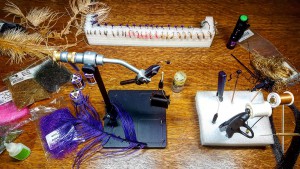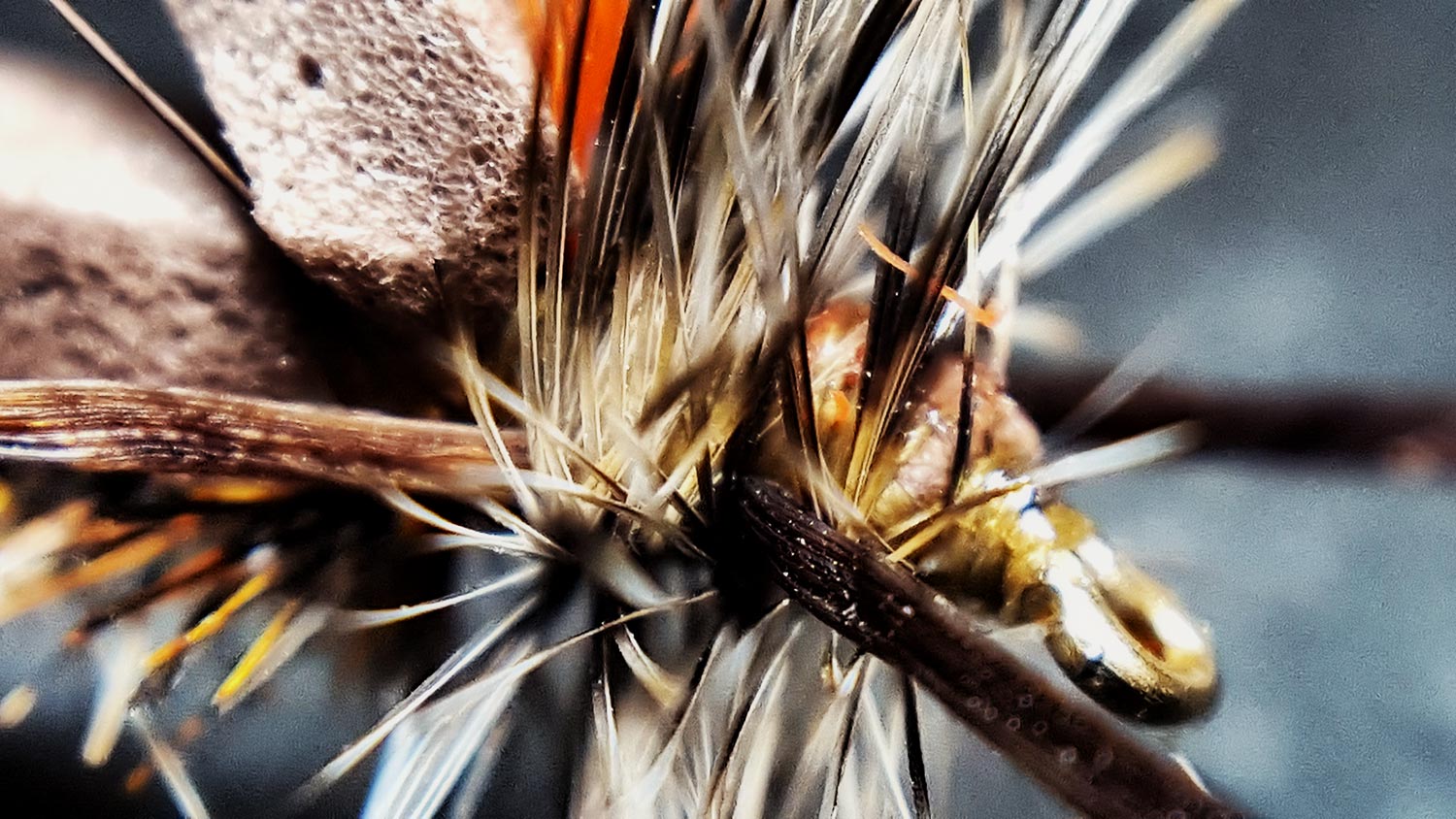By Bob Reece
All journeys do begin with a single step.
Yet, the quality and direction of that step sets the tone for the rest that follow. This holds true for those people that are just entering the domain of fly tying.
Overwhelming is the word that I hear the most when talking to new tiers about them attempts to “get started”. The growth of this art form and the explosion of online outlets has created a labyrinth for those who are just starting out. Sound advice on how to begin can make a huge difference in the enjoyment level of this venture.
When my dad sat me down at his old oak desk to tie my first fly, he kept it simple. During those first few weeks he helped me focus on a modest selection of tools and techniques. Once I was introduced to these humble beginnings, he made a point to help me master them before moving on to anything else. This lesson will forever stay with me and has had a huge impact on my journey as a tier.
 Among the aspects of this first lesson was an introduction to the basic tools that I would be using, attaching the thread to the hook and tying a half hitch. I’ve used these same starting points with the numerous new tiers that I’ve taught over the past decade. They still work as well as they did for me.
Among the aspects of this first lesson was an introduction to the basic tools that I would be using, attaching the thread to the hook and tying a half hitch. I’ve used these same starting points with the numerous new tiers that I’ve taught over the past decade. They still work as well as they did for me.
If you’re just moving forward into the world of fly tying, take a simple first step. Introduce yourself to and master these fundamental concepts. This sound start to your journey will result in an arrival at a long term destination of higher quality.
Vise Basics:
Basic Tying Tools Video:
The Half Hitch:
To see more of Bob Reece’s Beginning Fly Tying videos, click on the link below:
http://www.thinairangler.com/begining-fly-tiers
To explore the private water fly fishing options at Horse Creek Ranch, click on the link below:
http://www.thinairangler.com/horse-creek-ranch-fly-fishing
To step up your tying and fly fishing game, connect with Bob Reece as your Fly Coach through the link below:
http://www.thinairangler.com/fly-coach
Bob Reece Gink & Gasoline www.ginkandgasoline.com hookups@ginkandgasoline.com
 Sign Up For Our Weekly Newsletter!
Sign Up For Our Weekly Newsletter!


This is a copy of a post I wrote on Fb on “To tie or not to tie”
To tie or not to tie, that was the question. In my case I had flyfished for 46 years and had always bought my flies.
Then in 2009 I made the decision to go to Kiritimati (Christmas Island, one of five in the world) and fly fish for Bonefish. I also decided I would tie my own flies.
I had been working in the IT industry for 45 years so had a good knowledge of the use of search engines and how to get specific results and miss all of the dross.
I am a Planner/Trainer by temperament and my modus operandi has always been to follow the 3Es, the 3Ps and the 7Ps. That is develop the most Efficient, Effective, Economic method to do everything. Remember, Prior, Proper, Planning, Prevents, Pathetically, Poor, Performance and lastly Practice, Practice, Practice.
As I lived in the Northern Rivers area of NSW I was a cut lunch and water bottle away from any half decent Fly shop I decided to rely on my own research supported by a couple of mates in the industry who had been to Kiritimati a couple of times.
My other problem was the connectivity speed I had on the internet. I found if I wanted to watch Youtube I had to be prepared to take 10 minutes to watch a 4+ minute clip which in most cases didn’t give me enough detail.
So I went the other way and found step by step tying instructionals.
Now I have a data base with 1,000+ fly tying instructionals, 370+ docs on tying tools and materials and 1,700 docs on flyfishing, mainly saltwater. This info will continue to expand as I see new and better ideas.
The line speed has also improved dramatically so I now watch a few vids and if they can expand my knowledge I have added their links to my fishing database.
Now nine years later I have caught a few Bonefish as well as 40 plus other saltwater species and a few freshwater species on flies I have tied.
I don’t know how many flies I have tied and I tie sixty odd patterns and variations of those patterns. I use hooks, mainly 2X or heavier, in sizes from #8 to 7/0.
There are a couple of sites with good info. “Try on Fly”, “Jack Gartside”, “Kilroy’s” and “The Feather Bender” come to mind.
I also get newsletters from any site I have found in the past nine years which at the time I thought could help me.
In the past five plus years I have expanded my sources by joining several Fly Tying Groups on Facebook.
For me it has been a great and sometimes frustrating journey and it is one I will continue along for many more years.
I hope this has helped and good luck with your journey.
Cheers BM
Bruce this is not a “copy” of your post. The typed and video materials are my original creation. It may be similar content but it was generated by me. I’m glad you’re enjoying your fly tying and fishing journey.
Bob. Great article and I see the need to go back and re-learn some of these basics from time to time when I get stuck on something more complex.
It sounds like, maybe, Bruce meant to say… “Here is a copy of…” or “Below is a copy of…” and then point to a piece with a some tips he’d learned as a beginning fly-tyer – rather than pointing out that yours was a “copy” of his.
Thank you Todd I appreciate that and the added insight. Have a good one!
I would highly recommend the following YouTube tiers:
Tim Flagler (Tightline Productions)
Tim is an awesome teacher and each video contains tips that will help the beginner as well as the experienced tier.
Davie McPhail
Once you get used to his heavy Scottish accent, the techniques he uses are about as good as they get. A true master fly tier.
Bob Reece
Another superb teacher of the art. These three videos are fantastic starting point for the beginner., pick a few simple to tie patterns that are proven fish catchers.
For trout:
1) Wooly Bugger 2) Pheasant Tail nymph or Hare’s Ear nymph
3) The Usual emerger 4) Comparadun dry fly (Sparkle Dun)
Most of us old timers spent our early years using a Thompson Model A and a printed tying manual filled with blurry black and white photos, YouTube and Vimeo are a godsend for beginners.
Many TU chapters offer fly tying classes for beginners with small group instruction – take advantage of these offerings. Just don’t get overwhelmed by the volume of information. Pick 3 or 4 simple patterns that are proven fish catchers and work to develop the fine motor skills and muscle memory that eventually make fly tying a relaxing and rewarding part of the fly fishing experience.
There really is nothing like catching that first fish on a home tied fly.
Rick,
Great advice and thank you for the kind words. I really appreciate that. I agree too, Davie and Tim are exceptional tiers and teachers.
As a brand-new-to-the-vise tier, this is a great article. I inherited a vast amount of material and a vise I can barely get set up from my dad. Thanks for breaking things down into manageable pieces.
Happy to help Rick, let me know if I can help in any other way. Have a good one